Floral print, silk long Cheongsam with cap sleeves
$88.00
Shipping calculated at checkout.
- The measurements in the size chart are based on clothes. Not your body measurements. So you will choose a size a little Larger (about 0.5-1″) than your body size. If any part of your body especially the busts or hips at the upper end of the size range then please choose the next larger size range.
- If your measurements happen to be between two sizes, please choose the next bigger one.
| Size | Bust | Waist | Hips | Dress Length | Shoulder Width |
|---|---|---|---|---|---|
| M(inch) | 33.07 | 27.56 | 34.65 | 49.21 | 14.57 |
| M(cm) | 84.00 | 70.00 | 88.00 | 125.00 | 37.00 |
| L(inch) | 34.65 | 29.13 | 36.22 | 49.21 | 14.96 |
| L(cm) | 88.00 | 74.00 | 92.00 | 125.00 | 38.00 |
| XL(inch) | 36.22 | 30.71 | 37.80 | 49.21 | 15.35 |
| XL(cm) | 92.00 | 78.00 | 96.00 | 125.00 | 39.00 |
| XXL(inch) | 37.80 | 32.28 | 39.37 | 49.21 | 15.75 |
| XXL(cm) | 96.00 | 82.00 | 100.00 | 125.00 | 40.00 |
| 3XL(inch) | 39.37 | 33.86 | 40.94 | 49.21 | 16.14 |
| 3XL(cm) | 100.00 | 86.00 | 104.00 | 125.00 | 41.00 |
| 4XL(inch) | 40.94 | 35.43 | 42.52 | 49.21 | 16.54 |
| 4XL(cm) | 104.00 | 90.00 | 108.00 | 125.00 | 42.00 |
Qipao Details
Qipao dresses are a symbol of timeless Chinese elegance, featuring graceful cuts and luxurious fabrics perfect for any formal event.
- Material:Artificial silk
- Thickness: Moderate thickness
- Elasticity: Slightly elastic
- Feel: Drape, soft, comfortable, breathable
- Occasions: Events, meetings, and special occasions
- Please check out HERE for Qipao for Special Occasions if you like this style!
- Follow Us:Instagram 、Facebook 、Youtube 、Tiktok 、Pinterest





The cheongsam, or 旗袍, is one of the most iconic traditional dresses in China. It began during the Qing Dynasty as a long, loose robe worn by Manchu women.
At that time, it was simple and modest. The dress covered most of the body and allowed for ease of movement in daily life.
However, in the 1920s, the style began to change. Women in Shanghai started wearing a slimmer, more modern version of the dress.
As a result, it became a symbol of elegance and female independence. The new design highlighted the body’s shape and featured stylish cuts.
By the 1930s, the dress was popular in major cities. Many educated and working women wore it as a sign of progress and pride.
Later, in the 1950s, it declined in mainland China due to political and social changes. People chose simpler, more casual clothing instead.
Even so, the cheongsam remained common in Hong Kong and Taiwan. Women continued to wear it at formal events and celebrations.
In recent years, the dress has made a strong comeback. Designers now mix traditional patterns with modern fabrics and colors.
Today, it is worn during weddings, festivals, and fashion shows. Each piece tells a story of beauty, culture, and history.
Although the style has evolved, its spirit remains the same. It continues to represent grace, confidence, and Chinese identity.
In short, the cheongsam connects the past with the present. Through its timeless charm, it inspires both tradition and creativity.
| Weight | 1 kg |
|---|---|
| Color |
Green |
| Size |
M ,L ,XL ,XXL ,3XL ,4XL |
- The measurements in the size chart are based on clothes. Not your body measurements. So you will choose a size a little Larger (about 0.5-1″) than your body size. If any part of your body especially the busts or hips at the upper end of the size range then please choose the next larger size range.
- If your measurements happen to be between two sizes, please choose the next bigger one.
| Size | Bust | Waist | Hips | Dress Length | Shoulder Width |
|---|---|---|---|---|---|
| M(inch) | 33.07 | 27.56 | 34.65 | 49.21 | 14.57 |
| M(cm) | 84.00 | 70.00 | 88.00 | 125.00 | 37.00 |
| L(inch) | 34.65 | 29.13 | 36.22 | 49.21 | 14.96 |
| L(cm) | 88.00 | 74.00 | 92.00 | 125.00 | 38.00 |
| XL(inch) | 36.22 | 30.71 | 37.80 | 49.21 | 15.35 |
| XL(cm) | 92.00 | 78.00 | 96.00 | 125.00 | 39.00 |
| XXL(inch) | 37.80 | 32.28 | 39.37 | 49.21 | 15.75 |
| XXL(cm) | 96.00 | 82.00 | 100.00 | 125.00 | 40.00 |
| 3XL(inch) | 39.37 | 33.86 | 40.94 | 49.21 | 16.14 |
| 3XL(cm) | 100.00 | 86.00 | 104.00 | 125.00 | 41.00 |
| 4XL(inch) | 40.94 | 35.43 | 42.52 | 49.21 | 16.54 |
| 4XL(cm) | 104.00 | 90.00 | 108.00 | 125.00 | 42.00 |

Where do we ship to?
We mainly ship to this list of Counties: USA,Canada Australia, New Zealand, Europe (England, Germany, France, Italy, Sweden, Denmark, Switzerland, Spain, Netherlands, Ireland, Norway etc), Asia (Singapore, Japan, South Korea, Singapore, Malaysia, Thailand, etc), We also deliver to Most of the countries in East Europe, South America, Middle East, and Africa and If you do not see your country listed, please contact us and we will make it happen!
How long will it take to receive my order?
- Orders are fulfilled in our warehouse in China and sent out within 48-72 hours of receiving payment.
- We offer standard shipping and express shipping. Express shipping takes up to 5-7 business days, and standard shipping takes up to 8-20 business days; However, delays can occur in transit, due to the holds at your local customs office, so it may take longer for an order to be delivered.
- Delivery times may vary by location, holidays, disaster, and weather.
- Orders are shipped in the order they are received throughout the workweek. If part of your order contains an item that is back-ordered, we may ship items separately. You will be notified via email if we do this to get prior approval.
How do I track my order?
Tracking information will be emailed to you once your order has been fulfilled and shipped out. You can track your package on our website or track it on a specific brand, such as DHL,USPS, FedEx,and other reliable shipping companies' websites by entering the tracking number we provided.
Return Shipping
You are responsible for any shipping fees in a return. See more information about returns and exchanges here: RETURN&EXCHANGE
Import Taxes & VAT for International Orders
Aslingood do not collect taxes from international orders therefore all taxes, duties, and customs fees are the responsibility of the recipient of the package.
Depending on the receiving country, your package could incur local customs or VAT charges. It happens rarely but we recommend contacting your local customs office for more information regarding your country’s customs policies.
Please call us or email us if you need help!
Notice:
-
- Please measure yourself and compare with our size chart under each item to find the right size for you.
-
- Please measure 2-3 times to be sure and record in centimeters.
-
- We strongly recommend that you have your measurements taken by a professional tailor.
-
- For custom orders, please wear the bra and shoes you plan to wear the Qipao with to ensure accurate measurements. Please provide body measurements and we will add more space accordingly.
Please provide your basic information to us:
Your height (cm), height of your shoes height (cm), your weight (kg).
How to Measure:

1. Bust
Wrap the measuring tape around the fullest part of your bust and center the tape on your back so it's leveled all the way around. Wear a bra while measuring if you plan on wearing one with the dress!
2. Waist
Measure around the natural waistline. ( Find the natural crease by bending to one side).
Note: Please measure around your lower abdomen as well if needed.
3. Hips/Butt
Feet together, measure fullest part around the bum.
4. Qipao length ( Shoulder to Hem )
Stand upright and measure from the midpoint of your shoulder straight down over the fullest part of bust measure to where you’d like the hem to end.
If your Qipao is floor length or fishtail please make sure measure from the midpoint of your shoulder straight down over the fullest part of bust down to your sole, and let us know your shoe height.
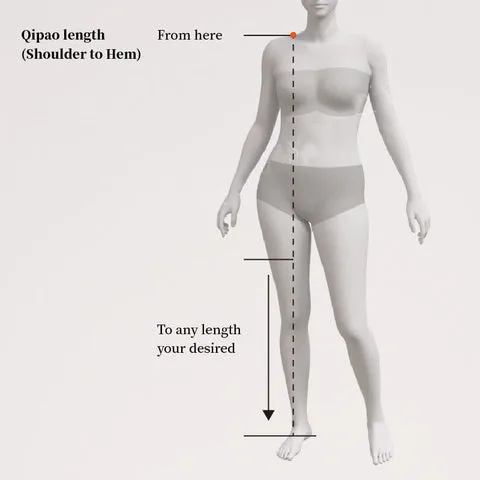
5. Shoulder width
If you lift up your arms, where your shoulder joint indents are where the measurement should start. You can also wear a fitted t-shirt and measure from one shoulder seam to the other.
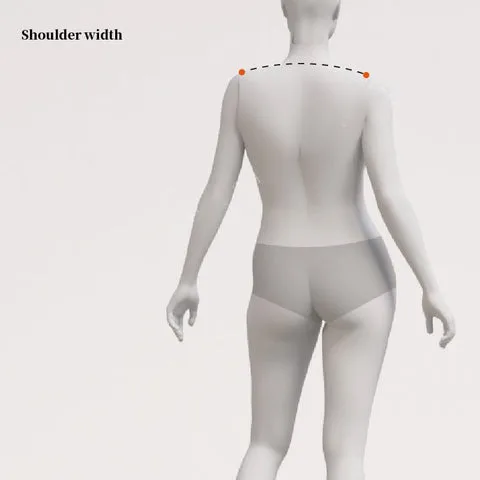
6.Shoulder to Apex
Measure from the midpoint of your shoulder down to the middle of your bust.
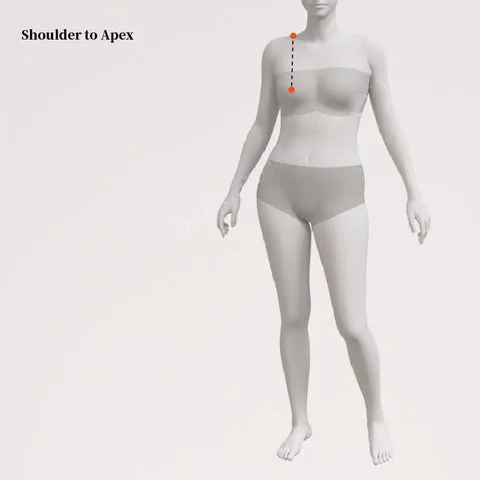
7.Apex to Apex
Measure the distance between the two apex points with measuring tape parallel to the floor.
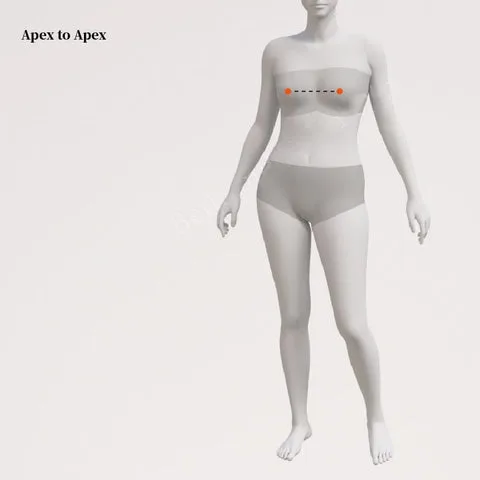
8. Shoulder to Waist
Measure from where the neck meets the shoulder, over the fullest part of the bust, to where the narrowest part of the waist sits.
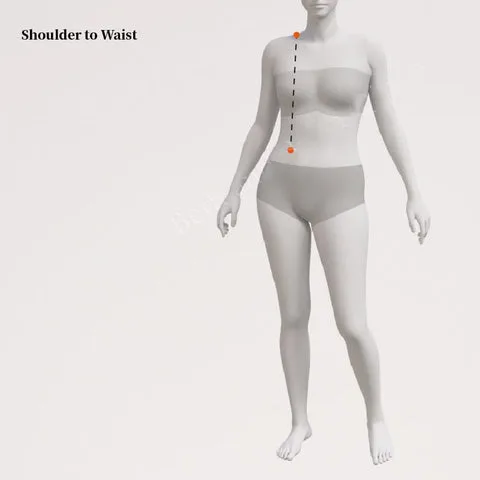
9. Back ( Back Armpit to Armpit )
Measure the distance between your two armpits on your back.
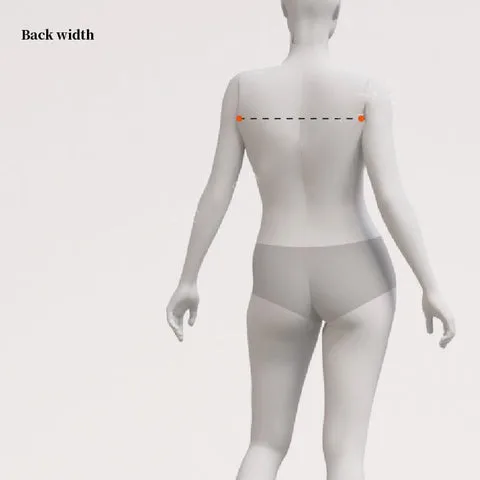
10. Armhole
Measure from the top outside edge of the shoulder down around armpit (360 degrees).
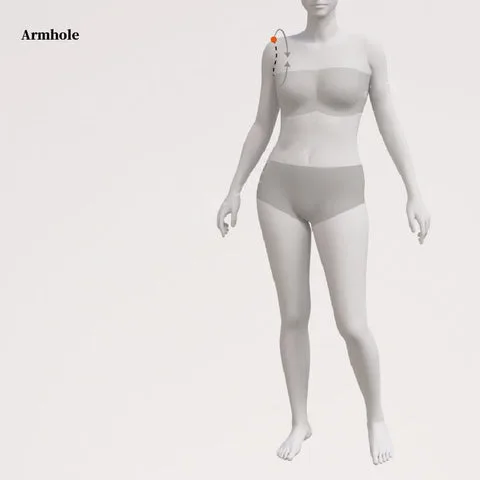
11. Bicep
Measure 360 degrees around the widest part of your biceps. Keep your arm relaxed.
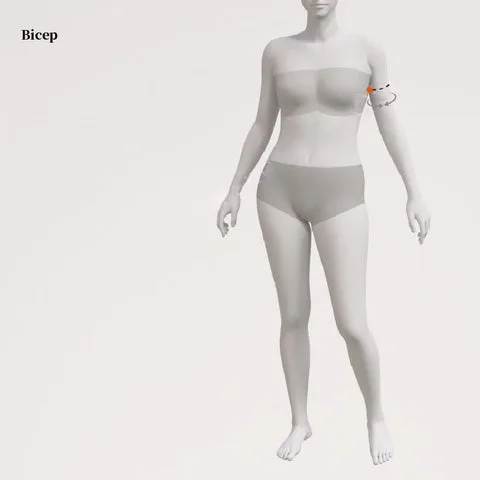
12.Neck
Measure 360 degrees around the base of your neck where a choker necklace would sit, with a finger added inside the tape for comfort.
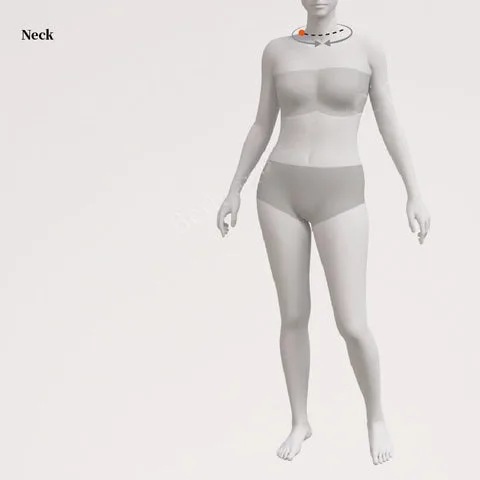












Reviews
Clear filtersThere are no reviews yet.